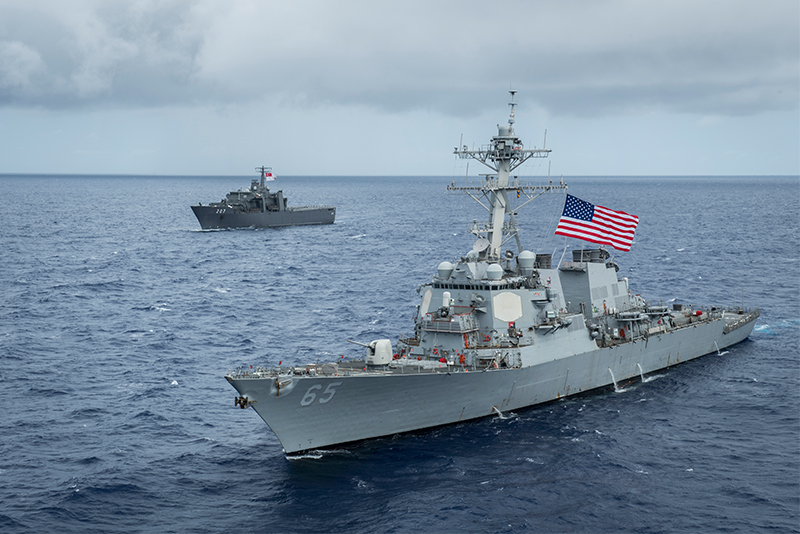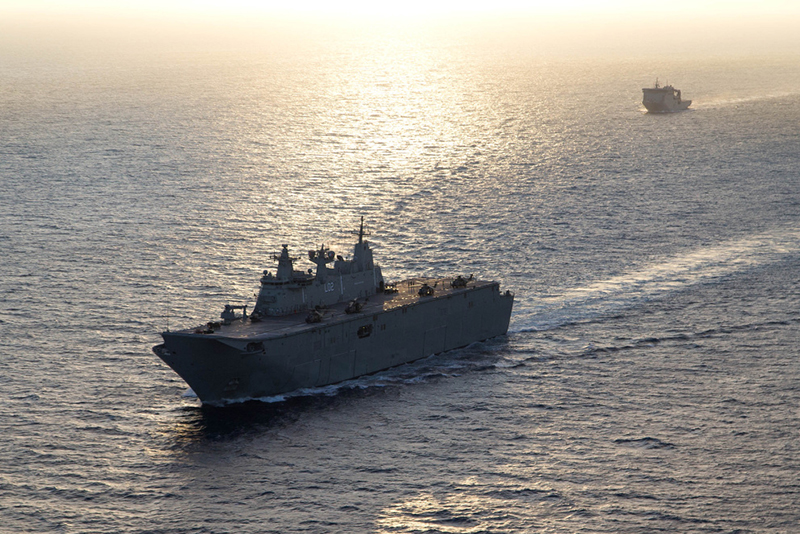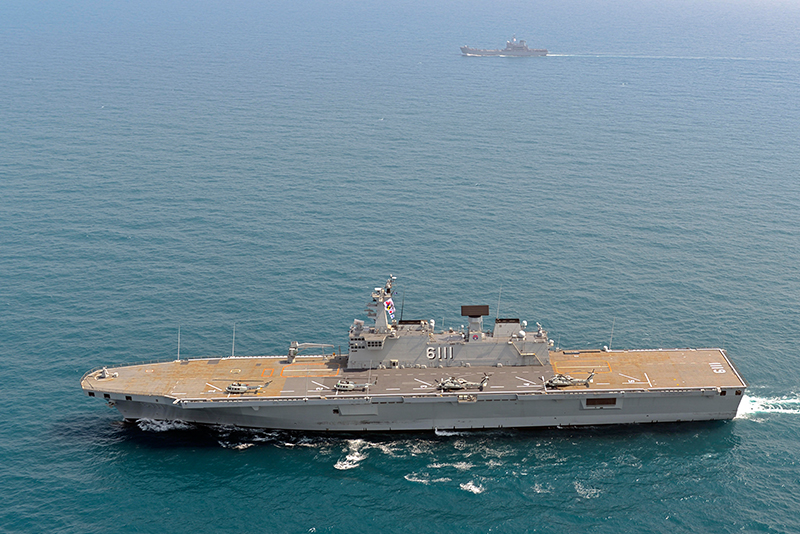Large ships can, by definition, support a number of tasks. Such flexibility inherent in both amphibious and logistics platforms is being exploited by a number of Asia-Pacific navies, as they seek to cover a range of operational requirements.
In December 2013, a US Navy (USN) Ticonderoga-class cruiser, USS Cowpens, was involved in an incident with a People’s Liberation Army Navy (PLAN) amphibious ship in the South China Sea. Cowpens was reported to have deployed to observe the operations of China’s first aircraft carrier, Liaoning, and its associated task group; the PLAN’s amphibious platform moved to deter the USN cruiser from conducting this task.

In October 2014, another PLAN amphibious vessel, the Type 071 landing platform dock (LPD) Changbaishan, demonstrated the range of tasks large-deck platforms can undertake by deploying to the Indian Ocean to support China’s naval escort flotilla rotations (which generate Beijing’s contribution to the international counter-piracy campaign off Somalia). The ship also pulled into the Sultanate of Oman’s port of Salalah, demonstrating a diplomatic role in the process.
On a number of recent occasions, the Royal New Zealand Navy’s (RNZN’s) multirole vessel HMNZS Canterbury also demonstrated this range of capabilities. In April 2015 and in February 2016, the ship deployed to support humanitarian assistance and disaster relief (HADR) operations in Vanuatu and Fiji respectively, both operations implemented in response to tropical cyclones. In the Fiji operation, HADR support was provided also by the Royal Australian Navy’s (RAN’s) lead landing helicopter dock (LHD), HMAS Canberra. At home, in November 2016, Canterbury played a central part in the HADR response to the earthquake that struck the south island’s Kaikoura region. The 9,000-tonne ship can embark a range of helicopters, and this capability was used to transport relief materials ashore and evacuate civilians. In this operation, Canterbury was joined by the RNZN’s fleet tanker, HMNZS Endeavour. Canterbury was conceived as the cornerstone of the New Zealand Defence Force’s emerging joint amphibious task force (JATF) concept. Speaking at the Defence and Security Equipment International (DSEI) maritime capability conference in London on 11 September 2017, RNZN chief Rear Admiral John Martin said that the navy is seeking to maintain credible capability across the spectrum of operations. Canterbury clearly provides capacity to cover a large part of this spectrum.

September 2017 saw three Republic of Singapore Navy (RSN) ships – including the navy’s lead LPD RSS Endurance, sail almost 5,000 km to waters off Guam in the western Pacific to participate in Exercise ‘Pacific Griffin’ with the USN, covering anti-submarine, anti-surface, and air-defence drills. According to a US 7th Fleet statement released on 5 September, the exercise was the first bilateral activity between the two navies away from Singaporean waters. One striking element was that the RSN deployed at distance once again without an auxiliary ship. The RSN has deployed ships to support Indian Ocean counter-piracy operations, including taking command of the USN-led Combined Task Force (CTF)-151. Such distant deployments demonstrate that the RSN has ocean-going capacity with its surface ships and amphibious platforms. This raises the question of if and when the RSN may procure a sovereign auxiliary capability to support its extensive area of operations.
- Options for the NZDF and RNZN 2nd enhanced Sealift vessel
- Other LHD operations
- Ship to Shore : Amphibious Support Ships in The The Asia-Pacific Region
- Why do I think the Endurance 170 LHD is a good choice for the RNZN.
These are a selection of examples demonstrating why and how Asia-Pacific navies deploy platforms such as amphibious and logistics vessels. Such ships, with their size and the inherent flexibility this brings, provide navies with the opportunity to maximise platform use for a range of operations, regardless of the platform’s design and broad capability outfit. Reflecting also a trend across the Asia-Pacific region, this means a range of operations across the spectrum of requirements can be met with one platform.

A general discussion of amphibious and logistics ships might not find much overlap in capability or role. However, naval operations in the Asia-Pacific region are seeing both types employed for a range of tasks, in large part due to their size and flexibility. In this context, it is notable that the use of large, multi-purpose vessels in the region is growing, both in terms of navies procuring multirole vessels and in how they are using single-role ships for a range of purposes.
Amphibious operations
Amphibious platforms are generally procured to support higher-end operations, principally the need to project power ashore from the sea, with military force deployed over the beach by helicopter and/or landing craft. At a time of significant strategic instability in the Asia-Pacific region, due in part to a number of territorial disputes (especially in the South China Sea), some analysts see amphibious capability as being central to shaping the regional power balance. Recent years have seen amphibious patrols and exercises conducted in disputed areas, demonstrating a different aspect of the utility of amphibious ships in flying the flag.
Nick Childs, senior research fellow for naval forces and maritime security at the International Institute for Strategic Studies (IISS), told AMR that “in a region of contested territorial and maritime claims, a key driver is, if not classic power projection, at least the ability to deploy and sustain forces at range over a wide area”. Amphibious forces based on large, flexible platforms are a core component of this capability.
- How much for an enhanced sealift vessel?
- Making tracks to New Zealand
- Sense of scale
- The New Zealand Defence Force’s expanding amphibious capability
A number of different Asia-Pacific navies are investing in new amphibious capabilities. The RAN has welcomed into service its two Canberra-class LHDs, Canberra and HMAS Adelaide. The 26,000-tonne ships, commissioned in November 2014 and December 2015 respectively, bring the capacity to deploy eight helicopters and 1,000 troops. Along with the 16,400-tonne Bay-class landing ship dock (LSD) HMAS Choules, the ‘Canberra’ class provides Australia’s amphibious capability.
A defence spokesperson told AMR that the ‘Canberra’ class provides the Australian Defence Force (ADF) “with the ability to undertake a range of operations, including supporting the maritime security of South East Asia and Pacific Island countries, and addressing emergent threats in the broader Indo-Pacific region”.
“The flexibility inherent in the amphibious capability of the LHD provides the capacity to respond to a range of contingencies,” the spokesperson added: such contingencies include short-notice HADR operations, non-combatant evacuation operations (NEOs), and “opening a point of entry in a hostile environment”.

The RAN’s concept of operations is to ensure that “at least one of these [three] ships is available at very short notice throughout the high-risk weather season (November through April) to support the provision of HADR if required”, said the spokesperson. This three-ship capability also allows “a regional response capability [to] be maintained in addition to year-round international engagement, support of raise/train/sustain activities, and, importantly, the development of ADF amphibious warfighting capabilities.”
For the ‘Canberra’ class in particular, the spokesperson added that its command, control, and communications (C3) capabilities mean that, in terms of supporting cross-government responses to regional contingencies such as HADR, the ships are “well suited for the embarkation of non-military personnel from a wide range of government agencies and non-government organisations”; such capacity, the spokesperson continued, will be developed further to build the platforms’ impact, including through embarking other government stakeholders for training and exercise activities.
As regards the amphibious output, the spokesperson said this capability is scalable, ranging from one ship embarking a combat team landing force “through to the full amphibious capability of the medium-weight battlegroup, requiring all three vessels and a supporting maritime task group”.
- The rise of the multirole vessels
- The US military ran the largest stress test of its sealift fleet in years. It’s in big trouble.
- A closer look at the Endurance 160 LHD
- New Chinese Assault Carrier Catches Fire
The ships’ amphibious capability is something the RAN shares with joint and combined partners, with the Australian Army providing the landing force and the US Marine Corps keen to tap into the RAN’s capacity so as to boost its own regional presence.
For the recent exercise, ‘Talisman Sabre 17’, Canberra worked alongside a USMC contingent in amphibious serials. During Exercise ‘Hamel 2016’, USMC personnel were embarked in Canberra. The spokesperson added that “further opportunities are being explored by which the USMC can work with the RAN and the Australian Army across a range of training programmes,” adding that “this collaboration is expected to progress as the ADF amphibious capability matures.”
Australia of course has direct interests in the Indian Ocean. The Indian Ocean is seeing a significant increase in strategic focus from the world’s naval powers, and the potential deployment of a RAN task group including a number of amphibious platforms supported by air warfare destroyers and future frigates and submarines would create a powerful presence in this particular region.
As noted above, the PLAN has already been using amphibious forces to support operations in the ‘Near Seas’ (in and around the South China Sea) and ‘Far Seas’ (at distance in the Asia-Pacific, into the Indian Ocean, and beyond). It has also been working up amphibious task groups in home waters, as well as conducting amphibious exercises in the Asia-Pacific region.
The presence of PLAN amphibious ships in the Indian Ocean today is striking, especially in terms of China’s strategic balance with India. For example, the Indian Navy only has one large amphibious vessel, Jalawasha (a retired US Navy ship that first entered service in 1971). Pushing on from the Indian Ocean, and once again underscoring the diplomatic role that high-end amphibious ships can play, early 2015 saw Changbaishan and other PLAN platforms conduct port visits across the Mediterranean and northern Europe. While the navy has a number of amphibious platforms, Changbaishan and her three Type 071 Yuzhao-class sister ships are perhaps the PLAN’s most prominent LPDs. The 19,800-tonne ships can embark four landing craft air cushion (LCAC) vessels, four helicopters, and 800 troops.

China’s recent and rather rapid boosting of its ‘Far Seas’ operational capacity has been driven by the requirement to conduct NEOs for Chinese nationals caught up in crisis regions (such as Libya and Yemen). According to Childs, this is one particular area where amphibious shipping offers significant value for China.
The Japan Maritime Self-Defence Force (JMSDF) has a robust set of amphibious capabilities. Of prominence are its two 24,000-tonne Izumo-class ships, commissioned in 2015 and 2017 respectively. These platforms have been defined as destroyers or carriers, but are amphibious platforms capable of embarking up to 14 helicopters of various types. The JMSDF has another five amphibious platforms: two 18,000-tonne Hyuga-class helicopter carriers, and three 14,000-tonne Osumi-class LPDs. The former can embark 10 helicopters, with the latter able to deploy over 300 troops via two LCACs.
South Korea is perhaps the other regional navy with a robust amphibious capability focused on higher-end operations. In 2007, it commissioned its single ‘Dokdo’-class landing platform helicopter (LPH) ship. The 16,000-tonne vessel can carry 10 armoured vehicles and can deploy 700 troops ashore using two LCACs. The navy’s older fleet of ‘Alligator’-class landing ship tank (LST) vessels was boosted in 2014 with the arrival of Cheonwangbong, the first of four new 7,000-tonne LSTs; the remaining three are scheduled to arrive by 2019.

A number of other navies have been building amphibious capabilities, although arguably with such forces focused towards the lower end of the operational spectrum, such as for HADR operations. In the Asia-Pacific region, higher-end operations tend to be a source of confrontation between navies whereas tasks at the lower end of the scale tend to generate co-operation. According to Childs, using amphibious shipping to support HADR operations “can be a catalyst for growing regional and extra-regional naval and maritime partnering and co-operation”.
Such co-operation has been demonstrated in the recent exercise ‘Indo-Pacific Endeavour’, which took place in September 2017. According to an Australian government media release, Adelaide joined other RAN and ADF assets for the exercise, along with participation from more than a dozen regional countries: the exercise would also “[demonstrate] Australia’s ability to support humanitarian assistance and disaster responses throughout the region”, the release noted.
Indonesia is procuring a total of six ‘Dr Soeharso/Makassar’-class multirole vessels. Five of the 11,500-tonne ships are in service, with a sixth ordered in 2017. Providing both support and helicopter capabilities, the ships can embark two Airbus Helicopters AS332L Super Puma helicopters; 13 tanks or 500 troops can be deployed by landing craft from a well-deck.
The ‘Makassar’ design has also been used by Indonesia to build two strategic support vessels (SSVs) for the Philippine Navy.
In a second example of sharing amphibious ship designs, Thailand’s 7,600-tonne LPD Anthong is based on the RSN’s ‘Endurance’-class design and was built by Singapore shipyard ST Marine. The ship can embark 500 troops or 19 main battle tanks (MBTs), with landing craft utility (LCU) vessels used to deploy these capabilities.
The RSN itself has four ‘Endurance’-class LPDs, which entered service between 2000 and 2001. These are slightly larger, at 8,500 tonnes, and can embark two Super Puma helicopters, four landing craft vehicle personnel (LCVPs), 18 MBTs, and 350 troops. The ships have been used in a range of operations at distance, including supporting Indian Ocean counter-piracy operations and conducting round-the-world deployments.
Logistics support
Some Asia-Pacific navies with robust amphibious and other platform types designed for distant operations nonetheless have relatively limited support ship capacity.
The RSN, for example, has yet to invest in such capability. The JMSDF has extremely robust amphibious and surface ship capabilities, but has a modest support fleet including two ‘Mashu’-class and three ‘Towada’-class ships. Like all other elements of Japan’s armed forces, the JMSDF’s structure is built around a defensive disposition. It also has extremely robust operational ties with the USN. This explains its relatively small number of support ships, given its fleet size.
Conversely, the PLAN’s focus on boosting its ‘Far Seas’ operational capability – especially in the Indian Ocean and West of Suez – is reflected in its significant investment in afloat support. Of note here is the PLAN’s eight-strong fleet of Type 903/903A Fuchi-class replenishment ships. While the PLAN’s new basing access in Djibouti will bolster the operational capacity of ships operating in the Indian Ocean, as the navy deploys more regularly West of Suez then so afloat support becomes more important, as shore-based resupply points will be harder to find in the Mediterranean and beyond.
Other navies have used logistics ships to provide presence at distance. For example, the Royal Malaysian Navy (RMN) has deployed the first of its two 9,000-tonne ‘Bunga Mas’ support ships on Indian Ocean counter-piracy operations.
Russia has a significant focus on developing its strategic presence in the Asia-Pacific region. Its surface ships operating there are supported by eight auxiliary oiler replenishment (AOR) vessels. Four LSTs (three ‘Ropucha’ and one ‘Alligator’ class) are also based in the region. It is notable, however, that Russia has no larger amphibious platforms operating there. Russian plans in this area received a setback when France cancelled the sale of two ‘Mistral’-class LHDs in 2015: reports suggested these ships were set to be deployed to the Asia-Pacific region.




